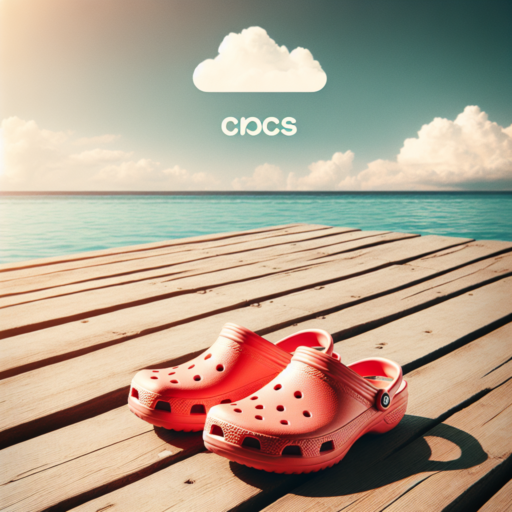What Are Crocs and Why Their Weight Matters
Crocs, a brand that has become synonymous with comfort and versatility, produces footwear that is unique for its lightweight construction and distinctive design. Originating as a simple boat shoe, Crocs have evolved into a fashion statement and comfort icon. Crafted from a proprietary material known as Croslite, a closed-cell resin, Crocs offer a blend of softness, durability, and odor resistance that sets them apart from traditional footwear. The significance of their weight, or rather, the lack thereof, plays a crucial role in their appeal and functional versatility.
The importance of the lightweight nature of Crocs cannot be overstated. It contributes to an array of benefits that enhance the user experience. First and foremost, the light weight reduces fatigue, making Crocs ideal for extended wear, whether for leisure or during prolonged standing jobs. Additionally, the minimal weight facilitates better foot and air circulation, which coupled with the inherent material properties, offers a comfortable experience reducing the chances of foot perspiration and odor.
Understanding the balance between lightness and durability is essential in appreciating the value Crocs bring to the footwear arena. The innovative construction ensures that despite their feather-light weight, they maintain a resilience that sustains daily wear and tear. This juxtaposition of durability and lightness is what makes Crocs not only a practical choice for everyday use but also a testament to the technological advances in footwear manufacturing.
How Much Do Crocs Shoes Weigh?
Understanding the weight of Crocs shoes is essential for those considering their comfort and practicality for everyday use or travel. Crocs are known for their lightweight design, making them a favorite among many. The actual weight can vary depending on the style and size of the Crocs.
Typically, a pair of adult Crocs shoes can weigh between 300 to 400 grams (0.66 to 0.88 pounds). This lightness is attributed to the Croslite material, a proprietary closed-cell resin used by Crocs, which contributes to both the light weight and the comfort of the shoes. Kids’ Crocs, being smaller, are even lighter, usually weighing around 100 to 200 grams (0.22 to 0.44 pounds) per pair. This makes Crocs an excellent option not only for daily wear but also for packing in luggage without adding much weight.
Among the various styles, some variations in weight are noticeable. For instance, the Classic Clogs are on the lighter end of the spectrum, whereas lined Crocs, intended for cooler weather, might be slightly heavier due to the added lining. Regardless, even the heavier styles remain significantly lighter compared to conventional footwear, emphasizing Crocs’s commitment to comfort and ease of wear.
Comparing Crocs Weight with Other Casual Shoes
When it comes to choosing the perfect pair of casual shoes, weight plays an surprisingly significant role. Crocs, known for their lightweight and comfortable design, offer a distinct advantage over many other types of casual footwear in terms of weight. This article dives into how the weight of Crocs compares to other popular casual shoes, providing insights that can help you make an informed decision.
Understanding the Lightweight Appeal of Crocs
The unique construction material of Crocs, called Croslite, is at the heart of their lightweight appeal. This proprietary closed-cell resin not only offers remarkable support and cushioning but is also remarkably light. When compared to traditional leather or canvas shoes, Crocs can feel like feathers on your feet, making them an excellent choice for all-day wear. The difference in weight is not just palpable but can also contribute to reducing overall foot fatigue, especially during long walks or standing periods.
Comparison with Other Casual Footwear
Crocs versus Sneakers: Modern sneakers, especially those designed for sports, have been focusing on reducing their weight, offering a closer competition to Crocs. However, even the lightest sneakers often cannot match the feather-light sensation provided by Crocs. The difference becomes apparent in activities that require prolonged periods of standing or walking, where Crocs’ lightweight advantage turns into a comfort feature that is hard to ignore.
Crocs versus Canvas Shoes: Canvas shoes, beloved for their simplicity and style, typically weigh more than Crocs. The heavier soles and denser materials used in canvas shoes contribute to their weight, contrasting with the airiness and buoyancy of Crocs. While canvas shoes offer a different style quotient, for pure comfort and ease of wear, Crocs still manage to stand out due to their lighter weight.
Factors That Influence the Weight of Crocs
The weight of Crocs can be influenced by a variety of factors, which matters significantly to consumers looking for comfort and utility in their footwear. Understanding these factors can help you choose the perfect pair of Crocs that meets your needs for weight and wearability.
Material Composition
The primary material used in Crocs, called Croslite, is a proprietary closed-cell resin that balances durability with lightweight. However, the density and amount of Croslite used can vary across different lines of Crocs, influencing the overall weight. Additionally, special editions and collaborations may incorporate other materials, such as leather or rubber, further affecting the weight.
Shoe Size and Style
The size of the shoe naturally plays a crucial role in its weight. Larger sizes contain more material, making them heavier. Moreover, the style of the Croc can also add to its mass; for example, designs incorporating thicker soles or additional elements like fleece lining for insulation will weigh more. It’s important to consider how the size and style of the Crocs align with your preferences for a heavier or lighter shoe.
Additional Features
Beyond the base material and size, additional features can significantly affect the weight of Crocs. Elements such as charms or Jibbitz, straps, and even LED lights in some children’s models add extra weight. While these features enhance the functionality or aesthetic appeal of the Crocs, they can make the shoes heavier than their basic counterparts. Assessing whether these bonus features outweigh the potential increase in weight is crucial for buyers.
Are Lighter Crocs Better? Benefits of Lightweight Footwear
The debate around whether lighter Crocs are better is not just about fashion; it revolves significantly around the benefits they offer in terms of comfort and practicality. Lighter footwear, such as the consistently popular Crocs, promises an enhanced user experience with its featherlight presence. This element alone can lead to a notable difference in daily wearability and long-term foot health.
Enhanced Comfort and Reduced Fatigue
One of the most immediate benefits of lightweight Crocs is the increased comfort level. When footwear is lighter, you’re carrying less weight on your feet throughout the day, which can certainly reduce fatigue. This is especially beneficial for individuals who spend a large portion of their day standing or walking. Less weight means less strain on your feet, ankles, knees, and back, contributing to a more comfortable and potentially pain-free experience.
Improved Mobility and Performance
Another significant advantage of lighter Crocs relates to mobility and overall physical performance. Lighter shoes enable quicker movements and can improve your speed, especially beneficial for athletes or anyone with a highly active lifestyle. Whether it’s a sprint to catch the bus or a leisurely walk in the park, lightweight footwear like Crocs can subtly enhance your mobility without you even noticing.
The benefits of opting for lighter Crocs extend beyond mere comfort and convenience. By fostering better foot health, reducing bodily strain, and enhancing mobility, lightweight footwear proves to be a wise choice for anyone valuing their well-being. The shift towards lighter Crocs and similar footwear options certainly underscores the growing awareness and emphasis on health-centric fashion choices.
No se han encontrado productos.
How Crocs’ Weight Affects Comfort and Usability
The relationship between the weight of Crocs and their overall comfort and usability is a critical aspect for consumers seeking both practical and cozy footwear. Lightweight shoes are a hallmark of the Crocs brand, allowing for ease of movement and prolonged wear without discomfort. Yet, the question remains: How does the weight of these iconic shoes influence their comfort levels and practical applicability in daily use?
Firstly, the lightweight nature of Crocs contributes significantly to their comfort factor. Made from a proprietary material called Croslite, a closed-cell resin that is both lightweight and soft, Crocs ensure that the feet are cushioned comfortably with every step. This feather-light material reduces the stress on feet, ankles, and lower leg muscles, making Crocs an ideal choice for people who spend long hours on their feet. Therefore, the weight of Crocs directly correlates with their ability to provide unparalleled comfort.
Moreover, the usability of Crocs in various settings also owes much to their lightness. Be it for casual walks, professional use in medical and hospitality industries, or even water-related activities, the minimal weight of Crocs ensures that they are not just easy to wear but also effortlessly versatile. This adaptability, enhanced by their weight, ensures that Crocs remain a popular footwear choice for diverse activities, underscoring the importance of weight in shaping the usability aspect of these shoes.
Choosing Your Crocs: Weight Considerations for Different Styles
When deciding on the perfect pair of Crocs, many potential buyers prioritize style and color. However, one aspect that often goes overlooked is the weight of the footwear. Different styles of Crocs can vary significantly in weight, affecting both comfort and utility. Understanding the weight implications of each Croc style is essential for making an informed choice that meets your needs.
Classic Clogs, the quintessential Crocs style, offer a lightweight feel that has contributed to their popularity. Their aerated design not only allows for breathability but also minimizes the material used, resulting in a pair of shoes that barely adds any noticeable weight to your feet. This makes them ideal for those who value comfort and ease of movement above all.
On the other hand, styles such as the Literide Clogs or Busy Day Shoes incorporate more substantial materials to provide additional support and cushioning. While this means they can be slightly heavier than the Classic Clogs, the difference in weight is a trade-off for enhanced comfort and durability. These styles are particularly well-suited for individuals who spend a significant amount of time on their feet and require shoes that can keep up with a more demanding lifestyle.
The Impact of Crocs Weight on Shipping and Handling
Understanding the impact of Crocs weight on shipping and handling is crucial for both businesses and customers. The unique material and structure of Crocs mean they are lighter than many traditional footwear options, impacting shipping strategies and costs. This aspect is particularly relevant as e-commerce continues to grow, requiring efficient and cost-effective shipping solutions.
Firstly, the lightweight nature of Crocs can lead to reduced shipping costs. For logistic companies, the cost of shipping is often determined by the weight of the package. Hence, lighter items like Crocs can be shipped at a lower cost compared to heavier footwear. This reduction in shipping cost is beneficial not only for the sellers, who can offer more competitive shipping rates, but also for buyers, who enjoy lower overall costs.
Additionally, handling and packaging requirements for Crocs are also impacted by their weight. Lighter packages are easier and quicker to handle, potentially increasing the efficiency of the shipping process. This efficiency can lead to faster delivery times, enhancing customer satisfaction. Moreover, the reduced need for heavy-duty packaging materials for lighter items like Crocs can further decrease shipping costs and minimize the environmental footprint of packaging.
Crocs Weight: Impact on Environmental Sustainability
The weight of Crocs, a popular footwear choice for individuals seeking comfort and versatility, plays a significant role in determining their environmental impact. As the global community becomes increasingly aware of the importance of sustainability, the lightweight nature of Crocs warrants a closer examination. A key factor to consider is how their weight affects the overall carbon footprint during manufacturing and transportation processes.
Lightweight materials in Crocs not only contribute to the convenience and comfort of the wearer but also reduce the energy consumption during the production phase. Fewer resources are required to manufacture a lighter shoe, which, in turn, leads to a reduction in the environmental toll associated with the extraction and processing of raw materials. This aspect of Crocs’ design demonstrates a move towards more sustainable fashion practices.
Transportation and Carbon Emissions
Furthermore, the impact of the weight of Crocs extends beyond production into the realm of distribution and transportation. Lighter products require less energy to transport, leading to lower carbon emissions. This has a direct implication for reducing the carbon footprint associated with the global distribution of footwear. By needing fewer resources for transportation, Crocs exemplify how product weight is crucial in promoting environmental sustainability in the fashion industry.
User Experiences: How the Weight of Crocs Influences Satisfaction
The discussion around Crocs, the popular footwear brand, often circles around their unique design and comfort level. However, an aspect that significantly impacts user satisfaction but is less talked about is the weight of the shoes. Lightweight footwear is not just a matter of convenience; it’s a crucial factor in how users interact with and ultimately feel about their Crocs. Exploring the influence of this characteristic can shed light on the nuanced preferences of consumers and the brand’s consistent appeal.
In the context of daily wear, the lightweight nature of Crocs plays a pivotal role in enhancing user experience. For individuals who spend a considerable amount of time on their feet, the absence of heaviness in their footwear can alleviate discomfort and fatigue. This is particularly significant in professions that demand constant mobility or in scenarios that involve extended periods of standing. The weight of Crocs, therefore, is not just about the physical attribute of the shoe but about the extended comfort and endurance it provides to its wearers.
Moreover, the correlation between the weight of Crocs and user satisfaction extends into the realm of psychological comfort. Wearing something light on the feet can offer a sense of freedom and ease, contributing to a more positive overall user experience. The psychological lift associated with wearing lightweight shoes like Crocs can enhance the perception of comfort, making the shoes not just a practical choice for everyday use but also a contributory factor to a user’s overall well-being.




